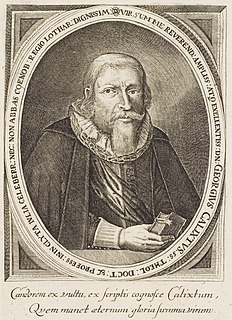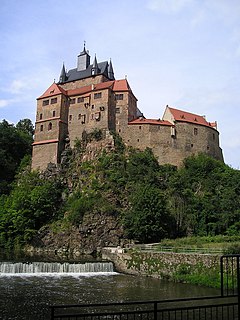
Matilda of Ringelheim, also known as Saint Matilda, was a Saxon noblewoman. Due to her marriage to Henry I in 909, she became the first Ottonian queen. Her eldest son, Otto I, restored the Holy Roman Empire in 962. Matilda founded several spiritual institutions and women's convents. She was considered to be extremely pious, righteous and charitable. Matilda's two hagiographical biographies and The Deeds of the Saxons serve as authoritative sources about her life and work.

The Second Dynasty of ancient Egypt is the latter of the two dynasties of the Egyptian Archaic Period, when the seat of government was centred at Thinis. It is most known for its last ruler, Khasekhemwy, but is otherwise one of the most obscure periods in Egyptian history.

Liudolf, a member of the Ottonian dynasty, was Duke of Swabia from 950 until 954. His rebellion in 953/54 led to a major crisis of the rising German kingdom.

Georg Calixtus, Kallisøn/Kallisön, or Callisen was a German Lutheran theologian who looked to reconcile all Christendom by removing all differences that he deemed "unimportant".

Hermann Friedrich Stannius was a German anatomist, physiologist and entomologist. He specialised in the insect order Diptera especially the family Dolichopodidae.

Castle chapels in European architecture are chapels that were built within a castle. They fulfilled the religious requirements of the castle lord and his retinue, while also sometimes serving as a burial site. Because the construction of such church edifices was expensive for the lord of the castle, separate chapels are not found at every seat of the nobility. Often, a secondary room furnished with an altar had to suffice.
Heidegger Gesamtausgabe is the term for the collected writings of German philosopher Martin Heidegger (1889-1976), published by Vittorio Klostermann.
Hans Wolfgang Helck was a German Egyptologist, considered one of the most important Egyptologists of the 20th century. From 1956 until his retirement in 1979 he was a Professor at the University of Hamburg. He remained active after his retirement and together with Wolfhart Westendorf published the German Lexikon der Ägyptologie, completed in 1992. He published many books and articles on the history of Egyptian and Near Eastern culture. He was a member of the German Archaeological Institute and a corresponding member of the Göttingen Academy of Sciences.

Kriebstein Castle is a castle in Kriebstein near the town of Waldheim in the German state of Saxony.

The Cross of Otto and Mathilde, Otto-Mathilda Cross, or First Cross of Mathilde is a medieval crux gemmata processional cross in the Essen Cathedral Treasury. It was created in the late tenth century and was used on high holidays until recently. It is named after the two persons who appear on the enamel plaque below Christ: Otto I, Duke of Swabia and Bavaria and his sister, Mathilde, the abbess of the Essen Abbey. They were grandchildren of the emperor Otto I and favourites of their uncle, Otto II. The cross is one of the items which demonstrate the very close relationship between the Liudolfing royal house and Essen Abbey. Mathilde became Abbess of Essen in 973 and her brother died in 982, so the cross is assumed to have been made between those dates, or a year or two later if it had a memorial function for Otto. Like other objects in Essen made under the patronage of Mathilde, the location of the goldsmith's workshop is uncertain, but as well as Essen itself, Cologne has often been suggested, and the enamel plaque may have been made separately in Trier.

The Cross of Mathilde is an Ottonian processional cross in the crux gemmata style which has been in Essen in Germany since it was made in the 11th century. It is named after Abbess Mathilde who is depicted as the donor on a cloisonné enamel plaque on the cross's stem. It was made between about 1000, when Mathilde was abbess, and 1058, when Abbess Theophanu died; both were princesses of the Ottonian dynasty. It may have been completed in stages, and the corpus, the body of the crucified Christ, may be a still later replacement. The cross, which is also called the "second cross of Mathilde", forms part of a group along with the Cross of Otto and Mathilde or "first cross of Mathilde" from late in the preceding century, a third cross, sometimes called the Senkschmelz Cross, and the Cross of Theophanu from her period as abbess. All were made for Essen Abbey, now Essen Cathedral, and are kept in Essen Cathedral Treasury, where this cross is inventory number 4.

Vera von Falkenhausen is a German Byzantinist who lives and works in Italy.
Ludwig Holtmeier is a German music theorist and piano player.
The Treaty of Coulaines, named after the western French locality of Coulaines near Le Mans, was concluded in late 843 between Charles the Bald, king of West Francia, and his nobility and clergy. Since its validity was limited to West Francia, it has been interpreted as marking the start of a divergence between the respective legal orders of what would become the Kingdom of France and the Kingdom of Germany, just a few months after the two realms had been defined by the Treaty of Verdun. The treaty restricted the powers of the king and guaranteed rights of the nobility and clergy.
Arnold Feil was a German musicologist and academic scholar.
Tall Bazi, is an ancient Near East archaeological site in Raqqa Governorate of Syria in the same general area as Mari and Ebla. It is located on the Euphrates river in upper Syria, about 60 kilometers south of Turkey near the abandoned town of Tall Banat. Tall Bazi has been proposed as the location of Armanum, known from texts of the Akkadian period, during the reign of Naram-Sin of Akkad. It was occupied into the Mitanni period at which time it was destroyed. In the late Roman Empire a large building was constructed at the top of the main mound.

The history of Saxon coinage or Meissen-Saxon coinage comprises three major periods: the high medieval regional Pfennig period, the late medieval Pfennig period and the Thaler period, which ended with the introduction of the Mark in 1871/72. Rich silver deposits, which were discovered near Freiberg after the middle of the 12th century, helped Saxony to a leading position in German coinage.
The regional pfennig was a type of pfennig, a low denomination coin used in the Holy Roman Empire that began to appear in the 10th century after the period of the supra-regional pfennigs following the coin reform of the Emperor Charlemagne of Francia. With the increasing allocation of royal minting rights under the Münzregal to other mints, different types of pfennig emerged. The mints with their own minting rights included those cities that had attained a special degree of independence, in some cases even imperial immediacy. However, a localization of coinage was partly counteracted by a move by cities to form minting associations or Münzvereins, in which minting agreement standards for the weight and, above all, the fineness of coins were set. which must not be undercut in order to ensure unrestricted convertibility of the coins within the contract area. In later centuries, larger denominations of higher value were introduced, such as the groschen (grossus) and, in the Alpine region, the Kreuzer. The pfennig thus fell from being a major coin and currency money to a small Scheidemünze coin. Attempts at standardisation concentrated on the new, larger denominations and no longer on the pfennig, which basically remained a state coin of only regional significance. In Germany, the pfennig was only successfully unified again in the 19th century, initially through the Prussian small coinage reform of 1821 for the various small coins in the Prussian provinces, and then through the second Imperial Coin Act of 1873.

The Sachsenpfennig, sometimes called the Wendenpfennig or the Hochrandpfennig was a well-known coin of the pfennig type minted in the eastern part of the Stem Duchy of Saxony during the 10th and 11th centuries. It had an upturned perimeter and, next to the Otto Adelheid Pfennig was the most common pfennig type of its time. Sachsenpfennigs are the oldest coins minted in Saxony. Its different names represent a lack of clarity within mediaeval numismatics about the coin.

A Scherf was a low-value silver coin used in Erfurt and other cities of the Holy Roman Empire from the Middle Ages to the 18th century. The name was later also given to a copper coin with a value of about half a pfennig. The simple scherf was only rarely minted; coins of 3, 6 and 12 scherf were more common, most recently in 1777 in Lüneburg.














